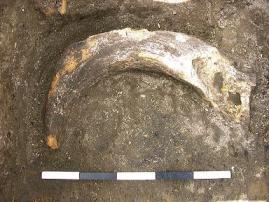Animal Bone Studies
Louise Martin, Nerissa Russell and Sheelagh FrameThe range of mammals found at Çatalhöyük continues to grow: to previous years list of sheep, goat, cattle, wild horse, two species of wild ass, red deer, roe deer, boar/pig, fox, wolf, dog and bear, we can now add fallow deer, wild cat, gazelle, badger and hedgehog. Bird bones, reptiles and amphibians continue to be rare, while small quantities of fish and small mammal bones are present in many deposits.
The South area deep sounding allowed a glimpse of patterns in the lower levels of the mound. Sheep and goat still dominate, and cattle and equids are a constant presence. The impression, however, is that boar/pig and cervids are more common than seen before. Whether these represent an earlier animal procurement pattern, with more hunted wild taxa brought to site, or distinct site-edge activities, remains unclear.
The two sizes of cattle noted in previous seasons (wild/domestic? male/female?) continue throughout the sequence. Cattle horncores were found in a variety of context types this season: one was plastered to a wall, while others in house infills and courtyard middens show the varied and often unremarkable treatment of these elements (Figure 22). The animal penning contexts in space 181 provide an insight into possible management practices on site. Here, the presence of very worn, and probably shed, decidious teeth of sheep/goats suggests that they were penned in these locations. |
 Figure 22: Horncore excavated in speace 115 midden |
Other notable finds from the South area are articulated paws of a felid (wild cat?) in Building 2, and a badger in Building 7, both of which may have been attached to skins. Work on oven rake-out deposits showed that bone-grease production was taking place inside houses. In the BACH area, a partial puppy skeleton over a platform (space 86) could represent either an offering or a natural death; and primary deposits of consumption refuse near the space 89 bucranium could represent some kind of house closing feast.
The KOPAL area showed a very different pattern of animal remains, with a high proportion of cattle, and significant amounts of dog and cervid bones. The large chunks of consumption-refuse bone in this area is suggestive of some kind of off-site feasting, although the material could also have been dumped from the mound into this off-site area.